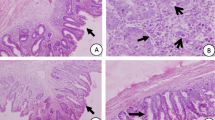Summary
Surgical ligation of chick ceca was used to study the role of absorption and extraintestinal transport in the action of anticoccidial drugs. The administration of drugs in the feed was started after ligation of one of the paired ceca. Birds were inoculated orally with oocysts ofEimeria tenella before cecal ligation or were given bilateral cecal injections of sporozoites after ligation. Cecal lesions caused by the coccidia were evaluated and compared on day 6 postinoculation.
Lesions in ligated and unligated ceca were reduced by feeding robenidine (33 ppm), arprinocid (70 ppm), zoalene (125 ppm), aklomide (250 ppm), clopidol (125 ppm), nicarbazin (125 ppm), monensin (120 ppm), salinomycin (60 ppm), and lasalocid (75 ppm). The lesions were more severe in the ligated cecum than in the intact cecum, whether in nonmedicated or medicated birds, but the differences were statistically significant only upon treatment with amprolium, aklomide, robenidine, and clopidol. Generally, however, all drugs except amprolium, significantly reduced the lesions in the ligated cecum in comparison with the control, nonmedicated ligated cecum. Therefore, we concluded that the systemic absorption of most anticoccidial drugs contributes significantly to their efficacy against coccidia in the intestinal mucosa.
Similar content being viewed by others
References
Ball, S.J.: Chemotherapy of caecal coccidiosis in chickens. The activity of nicarbazin. Vet. Rec.71, 86–91 (1959)
Bradley, R.E., Radhakrishnan, C.V.: Coccidiosis in chickens: Obligate relationship betweenEimeria tenella and certain species of cecal microflora in the pathogenesis of the disease. Avian Dis.17, 461–476 (1973)
Duncan, D.B.: Multiple range and multiple F tests. Biometrics11, 1–42 (1955)
Hymas, T.A., Stevenson, G.T.: A study of the action of zoalene onEimeria tenella andEimeria necatrix when administered in the diet or in the drinking water. Poult. Sci.39, 1261–1262 (1960)
Johnson, J., Reid, W.M.: Anticoccidial drugs: Lesion scoring techniques in battery and floor-pen experiments with chickens. Exp. Parasitol.28, 30–36 (1970)
Johnson, J., Reid, W.M., Kemp, R.L.: The development ofEimeria tenella in germfree chicks. In: Germfree research, J.B. Heneghan, ed., p. 457–460 New York: Academic Press 1973
Joyner, L.P.: The coccidiostatic activity of 3,5-dinitro-ortho-toluamide againstEimeria tenella. Res. Vet. Sci.1, 363–370 (1960)
Long, P.L., Millard, B.J.:Eimeria: Effect of meticlorpindol and methyl benzoquate on endogenous stages in the chicken. Exp. Parasitol.23, 331–338 (1968)
Matsuzawa, T.: Studies on the model of action of beclotiamine onEimeria tenella. Parasitology77, 235–241 (1978)
McDougald, L.R., Galloway, R.B.:Eimeria tenella: Anticoccidial drug activity in cell cultures. Exp. Parasitol.34, 189–196 (1973)
McDougald, L.R., Galloway, R.B.: Anticoccidial drugs: Effects on infectivity and survival intracellulary ofEimeria tenella sporozoites. Exp. Parasitol.40, 314–319 (1976)
McDougald, L.R., Galloway, R.B.:Eimeria tenella: Inhibition of development in cell culture by serum from chickens fed anticoccidial drugs. Z. Parasitenkd.54, 95–100 (1977)
Roger, E.F., Clark, R.L., Pessolano, A.A., Becher, H.J., Leanza, W.J., Sorett, L.H., Cuckler, C.C., McManus, E., Garzillo, M., Malanga, C., Ott, W.H., Dickinson, A.M., Van Iderstine, A.: Antiparasitic drugs. III. Thiamine reversible coccidiostats. J. Am. Chem. Soc.82 (2), 2974–2975 (1960)
Ryley, J.F.: Studies on the mode of action of quinolone and pyridone coccidiostats. J. Parasitol.53, 1151–1160 (1967)
Ryley, J.F., Wilson, R.F.: Studies on the mode of action of the coccidiostat robenidine. Z. Parasitenkd.37, 85–93 (1971)
Shumard, R.F., Callender, M.E., Reid, W.M.: Monensin, a new anticoccidial agent. 14th Cong. Mundial de Avicultura. Madrid, Spain, Vol.3, pp. 421–427 1970
Visco, R.J., Burns, W.C.:Eimeria tenella in monoflora and diflora chicks. J. Parasitol.58, 576–585 (1972)
Waletzky, E., Probst, R.: The role of absorption in the activity of anticoccidial agents againstEimeria tenella. J. Parasitol.43, (5) (suppl.) 18 (1957)
Author information
Authors and Affiliations
Rights and permissions
About this article
Cite this article
McQuistion, T.E., McDouglad, L.R. Eimeria tenella: Anticoccidial action of drugs in birds with surgically closed ceca. Z. Parasitenkd. 59, 107–113 (1979). https://doi.org/10.1007/BF00927392
Received:
Issue Date:
DOI: https://doi.org/10.1007/BF00927392




